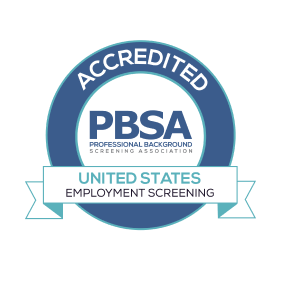Ensuring FCRA Compliance in the Age of Instant Background Checks
Hiring in a high-speed, tech-enabled world offers undeniable advantages. Recruiters and HR professionals can evaluate candidates faster than ever before. But with that convenience comes a pressing responsibility, one that’s often overlooked in the race to reduce time-to-hire: compliance with the Fair Credit Reporting Act (FCRA).
As a federal law governing the collection and use of consumer information, FCRA plays a pivotal role in employment background screening. But as automation, AI, and instant decision-making tools reshape the hiring process, so do the risks of non-compliance.
The Temptation of Instant Results
When timelines are tight and competition for talent is fierce, automated screening platforms promise a shortcut. A criminal background check returned in seconds, pre-screening scores based on algorithms, and even instant red-flag alerts on a candidate’s history can seem like the ultimate efficiency tool. However, without rigorous safeguards, these tools can put your company at risk.
Automated systems may incorrectly flag candidates, overlook context, or rely on outdated or incomplete data. In a world where a single record discrepancy can derail someone’s career, the consequences of unchecked automation extend far beyond the realm of HR. They can trigger lawsuits, reputational damage, and most critically, harm to candidates who were unfairly assessed.
What the FCRA Requires and Why It Still Matters
The FCRA mandates several important procedures that every employer must follow when using background checks in hiring decisions:
- You must obtain written consent from the candidate before conducting a background check.
- You must provide a clear disclosure that the report may be used for employment decisions in a standalone document.
- If you decide to take adverse action based on the background check (such as not hiring the candidate), you must follow a two-step notification process: first, provide a pre-adverse action notice along with a copy of the report and a summary of rights; then, after a reasonable waiting period, issue a final adverse action notice.
The intent is to give candidates a fair chance to dispute inaccuracies before a final decision is made. Skipping this due process, especially if your software makes an instant decision without human oversight, violates both the letter and the spirit of the law.
The Risks of “Black Box” Decision-Making
One of the most concerning developments in background screening is the use of opaque, algorithm-driven adjudication systems. These tools often score or grade applicants based on criteria that are not always disclosed or explained, even to the employer. The danger here is twofold: first, you may unknowingly make decisions based on flawed or biased data; second, you may not be able to justify or reverse those decisions if challenged.
For example, if a background check platform auto-generates a “Do Not Hire” recommendation based on a seven-year-old misdemeanor that is legally irrelevant to the job, your team may unknowingly act on a discriminatory or non-compliant basis. The FCRA requires that employers make individualized assessments and not rely solely on blanket exclusions or automated decisions.
Navigating Ban-the-Box and State-Level Fair Hiring Laws
Beyond federal law, hiring professionals must also account for a patchwork of local and state-level regulations, including Ban-the-Box laws and Fair Chance Acts. These laws restrict when and how criminal history can be considered in hiring, usually not until after a conditional offer is made. Automated tools that flag criminal history earlier in the process can put your organization out of compliance.
That’s where working with a partner like S2Verify proves invaluable. Our hybrid screening process blends automation with expert human review to ensure every report is accurate, legally compliant, and contextually evaluated. Our adjudication staff includes FCRA compliance experts and professionals with criminal justice backgrounds who review every flagged record for accuracy and relevance.
The Only Bullet Point You Need
If you’re using (or considering using) automated background screening, here’s what to demand from your provider:
- Transparent criteria, customizable to your hiring policies
- Built-in FCRA workflows for consent and adverse action
- Expert-reviewed reporting with clear context
- Real-time alerts and audit trails for compliance monitoring
- Integration with your ATS to eliminate manual data errors
Why HR Can’t Delegate Compliance to Software
Compliance is not just a checkbox; it’s a shared responsibility. No software, no matter how advanced, can absolve HR leaders of their duty to act fairly and lawfully. The burden still rests with you to ensure that every screening step, every adjudication decision, and every communication to a candidate aligns with regulatory expectations.
At S2Verify, we understand this distinction. We don’t just deliver data, we deliver peace of mind. Our platform automates what can be automated, while also incorporating the human intelligence and ethical oversight necessary to protect your business from costly mistakes.
Protecting Your Brand and Your Candidates
Candidates are more than their records. In the digital hiring landscape, your brand is more than just your benefits package or job listings; it’s the sum of how you treat people throughout the hiring process. Fair, respectful, and compliant background screening is not just a legal obligation. It’s a reflection of your company’s values.
The FCRA was designed to protect individuals from arbitrary, erroneous, and opaque decisions. Staying true to its principles means resisting the allure of instant decisions when those decisions could harm someone’s livelihood and your organization’s integrity.
Hiring Fast, Hiring Fair
Speed and fairness don’t have to be opposing forces in the hiring process. It’s possible, and increasingly necessary, for organizations to move quickly without compromising compliance or candidate experience.
That means choosing screening tools and processes that not only return results rapidly but also support transparency, accuracy, and legal adherence at every step.
As regulations evolve and candidate expectations rise, HR leaders who prioritize both efficiency and fairness will be best positioned to make strong, defensible hiring decisions without sacrificing the human element that defines responsible employment practices.







